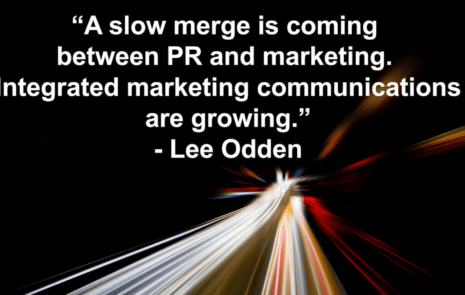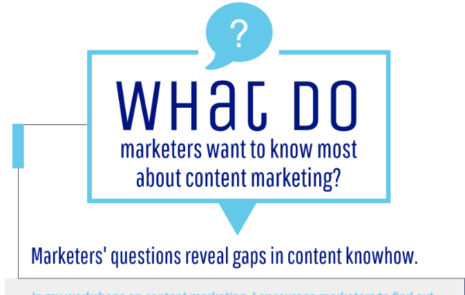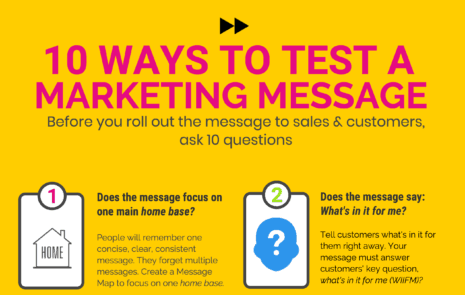
Message Maps Outperform Outlines, Scripts and PowerPoint
On stage, one page beats other formats
A 1-PageTM Message Map is a simple diagram that helps you deliver your business message even more effectively. Among its many uses, a Message Map helps you succeed in live events such as:
- Employee meetings
- Customer presentations
- Product demonstrations
- Sales conferences
- Speeches
- Interviews with news media
- Investor calls.
In all these situations, it’s no small challenge to hold your audience’s attention.
Here’s why audiences are likely to tune out during your talk. Human brains can process 400 words a minute, but people speak only about 125 words a minute.
Ouch. As you speak, more than two-thirds of your audience’s brainpower is idling, looking for something to do.
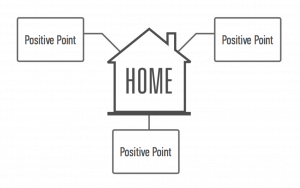
To hold your audience’s attention, create a powerful message in the form of a 1-Page Message Map. It puts you fully in command of your story, facts, and figures.
Since everything you need to know is right in front of you on one page, it’s easy to use the right words, state your case completely and keep your message consistent.
If your audience interrupts with a question, you’re likely to find an answer quickly on your Message Map. The answer, then bridge back to your main message (or home base).
If you don’t have a ready answer for a question, resist the temptation to make stuff up. Instead say, “I don’t know. I’ll find out and get back to you.” Then do so.
In live presentations, Message Maps help you much more than outlines, scripts, or PowerPoint slides can. Here’s how.
How Message Maps Beat Outlines
In school, we all learned to make outlines, a linear summary of a story. Outlines work best when you can tell your story from start to finish without interruptions.
But ask yourself: How often do you get to tell your story from start to finish with no one interrupting?
When you use an outline to give a talk, questions may derail you. That’s because people are seeking information that doesn’t necessarily follow the sequence in your outline.
The real problem is that, inside an outline, it’s hard to find your way around. That’s because there’s only one entry point – at the very beginning.
An outline makes you search through a document for answers. After you answer, it takes time to find your place and continue presenting. That may fluster you.
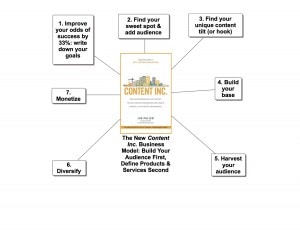
Compared with an outline, a Message Map offers much more flexibility. Each element in a Message Map is a potential entry point to your story.
Message Maps prompt you not only to answer questions but also to link your answers back to your main message. Repeating your main message with variation helps you get your point across and make it stick.
How Message Maps Beat Scripts
Many executives give presentations and speeches using scripts. As an outline, a script is linear, providing only one entry point at the very beginning.
Scripts need to be in a type size that’s big enough to read, even under the dim light of a hotel podium. Test the typeface and size in advance under similar lighting. Make sure it’s big enough for the presenter to read, ideally without glasses.
Scripts can be cumbersome, often numbering 20 pages or more. How often have you seen speakers shuffling through the pages of a script looking for their place?
Since it’s awkward to handle a stapled script on a podium, speakers often keep the pages loose and numbered. Each page must be handled perfectly as it moves from the “unread” pile into the “already read” pile.
I recall a painful moment in a shareholder meeting when a presenter grew bewildered because a page of his script went missing. He had no idea what to say next.
Unfortunately, two pages of his script had stuck together. Lucky for him, an executive figured out the problem, sprang to his rescue, reordered his script pages, and enabled him to continue.
God forbid, a script falls off the podium. Seen through the eyes of your audience, it takes forever to put all those loose pages back in order. That’s an awkward, painful moment.
Reading a script aloud can be deadly.
Speakers who read word for word lose the opportunity to make eye contact with the audience. They’re also confined behind the podium.
Speakers who use scripts may gesture less, especially when they’re holding the script in hand. And their gestures may be hidden behind the podium.
With a script, forget about spontaneity. It rarely occurs. Presenters using scripts may come across to the audience as wooden.
If a speaker hasn’t rehearsed enough with a script, he may stumble while reading aloud. On the other hand, if he’s rehearsed too many times, he may sound boring reading the speech for the umpteenth time.
Rehearse enough, but not too much. For most people, 3 rehearsals are enough to make you confident in your ability to deliver a speech. Never over-rehearse.
Some executives use a teleprompter so they don’t have to fumble with paper. But not every live meeting lends itself to a teleprompter.
If you haven’t used a teleprompter before, you may struggle to find the right reading pace – not too fast and not too slow.
When inexperienced presenters read aloud from a teleprompter, you often see their eyes gliding back and forth line by line. That’s not a great way to connect with your audience.
Compared with a script, a Message Map lets you give your whole speech from one piece of paper. Everything you need to know is right in front of you.
Message Maps offer these advantages over scripts:
- You can phrase your talk naturally rather than reading it word by word.
- You can make eye contact with supportive people in your audience.
- You can step away from the podium.
- You gain more freedom to gesture visibly.
- You’re prompted to reinforce your main message until it sinks in.
- You quickly find the answers to questions and bridge back to your home base.
How Message Maps Beat PowerPoint

The common currency of business meetings remains PowerPoint presentations. Often, PowerPoint is actually required. All too often, it’s utterly predictable and boring.
A few exceptional presenters create energetic presentations with PowerPoint or Prezi. Seth Godin, Guy Kawasaki, and Andrew Davis come to mind. Seeing them gives you a sense of how PowerPoint could look when its full potential is realized, which is a rare event. All three make presentations that sparkle, surprise, and delight audiences.
PowerPoint comes with a built-in disadvantage: it often requires you to draw the shades and dim the lights. It puts the focus on the screen rather than on the presenter or audience.
You can address this issue somewhat by standing to the left of the screen, as seen by the audience … so they see you first and then your slides.
A dull PowerPoint show in a darkened room invites audiences to become passive. “Research has proven that you have more brain activity going on when you sleep than when you watch TV. And PowerPoint is akin to TV,” observes Tim Riesterer.
Most PowerPoint presentations pack way too much information (TMI) into each slide, more than any audience could absorb. That means:
- The slides are overcrowded visually, with way too many words.
- The presentation carries multiple messages rather than one main message.
- The type is too small for some people in the room to read.
- The presenter is tempted to read the slides word for word.
- The audience reads ahead of the presenter, then their attention drifts away.
Like outlines and scripts, PowerPoint presentations are linear. They’re geared to present a story from start to finish without interruption.
When you need to find an answer to a question, PowerPoint is unforgiving. You often see presenters answer questions by flipping through their presentations forwards and backward.
Compared with PowerPoint, a Message Map enables you to keep the lights on, lead a discussion while making eye contact, answer questions and hold your audience’s attention. It gives you the flexibility to steer the discussion where the group wants to go, rather than along a predetermined linear path.
A Message Map Makes You More Powerful On Stage
A Message Map overcomes the problems with outlines, scripts, and PowerPoints. It is:
- Visual, so you quickly find your way to any point you want to make
- Simplified, so you tell stories that are easy to understand
- Structured, so you see how the dots connect logically
- Right-sized – it’s the size message audiences can easily absorb, with one main message, supported by 3 or 4 positive points
- Non-linear, so you start or finish anywhere, which is ideal for Q&A
- One page, so you never have to shuffle papers or slides to find answers.
That’s how Message Maps help you deliver live presentations even better.
Message Maps make it easy for you to get your point across while keeping your message concise, compelling, and completely consistent. Consistency is the path to gaining credibility with your audiences so you can more easily achieve your business goals.
Related Posts
To break through, keep your message short and sweet
To hook your audience quickly, make your message short and sweet. That’s the key to a breakthrough message. Make your message quick Short marketing...
PR + marketing = the future of content marketing
What does the future of content marketing hold? How will the practice of content marketing advance and evolve in the years ahead? Content marketing...
What do marketers want to know about content marketing? [Infographic]
“What are your top 3 content marketing questions?” That’s a question I asked hundreds of marketers in my workshops over the past year. An analysis of...
10 ideas to test a new marketing message before launch – Infographic
How to test a marketing message before launch How do you know if your marketing message works? Before you roll out a new marketing...


